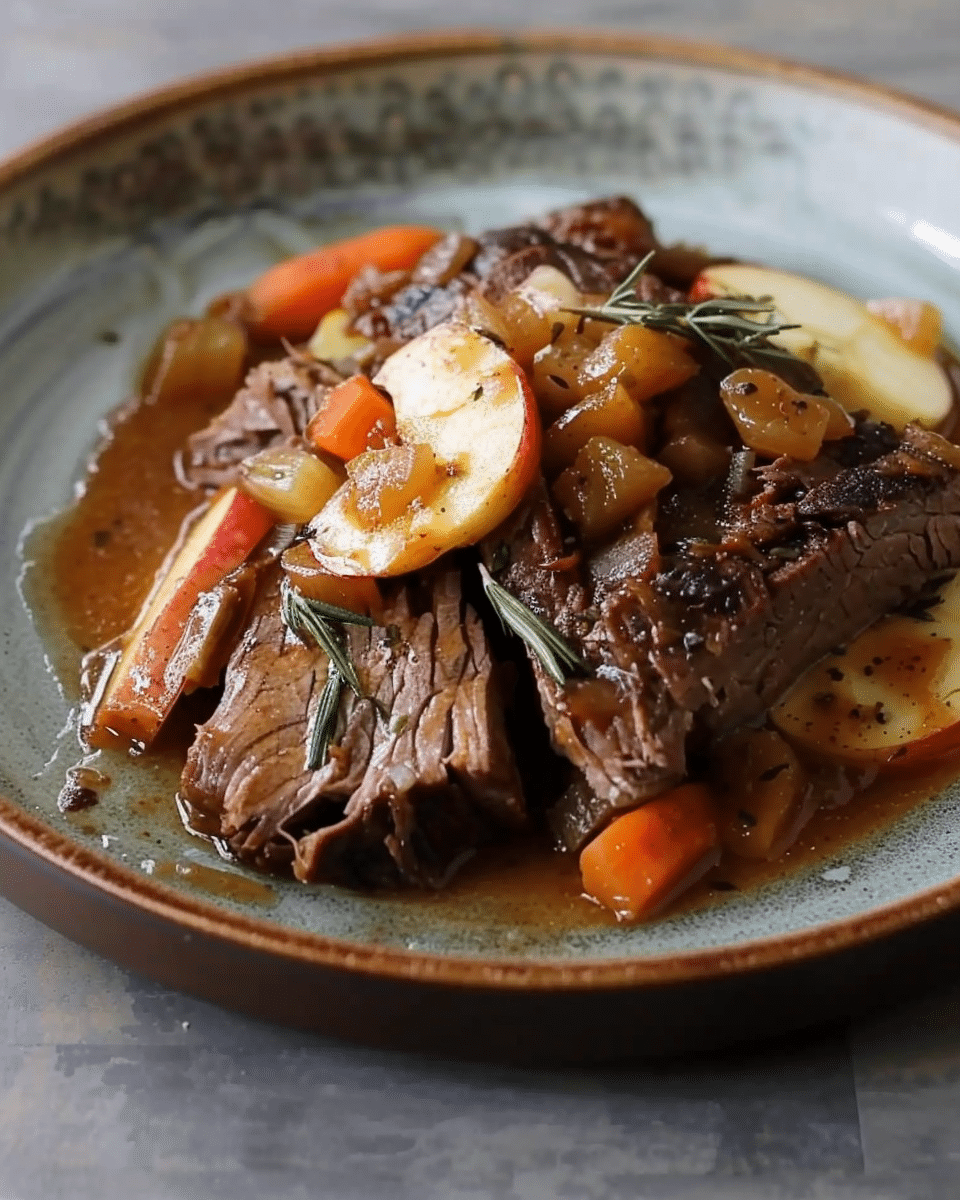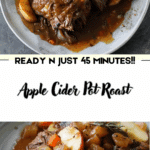Why You’ll Love Apple Cider Pot Roast
Recipe
The apple cider and cider vinegar bring a subtle sweetness and depth that elevate the classic pot roast.
It’s a one‑pot (or slow‑cooker) meal that’s mostly hands‑off once the browning is done.
The slow cooking makes the beef seriously tender—perfect for a family dinner.
The sauce doubles as a flavorful gravy to serve over mashed potatoes, enhancing the flow of flavors.
Ingredients
(Tip: You’ll find the full list of ingredients and measurements in the recipe card below.)
4 teaspoons kosher salt
2 teaspoons freshly ground black pepper
¼ teaspoon cayenne pepper
4 pounds beef chuck roast
1 tablespoon avocado oil (or other high‑heat vegetable oil)
3 tablespoons butter
1 yellow onion, diced
4 cloves garlic, minced
2 tablespoons all‑purpose flour
⅓ cup cider vinegar
4 cups apple cider
1 tablespoon Worcestershire sauce
2 tablespoons Dijon mustard
1½ teaspoons poultry seasoning
2 cups chicken broth
3 ribs celery, cut into ½‑inch pieces
3 large carrots, peeled and cut into 1½‑inch pieces
(Optional) 1 tablespoon cornstarch + 2 tablespoons water for slurry
Directions
-
Mix the salt, black pepper, and cayenne in a small bowl. Use this mixture to season all sides of the beef.
-
Add the oil to a large heavy‑bottomed skillet over high heat until shimmering. Sear the beef on both sides until well browned. Remove the beef and set aside.
-
Reduce heat to medium, add butter to the skillet. Add onion and a pinch of salt; cook, stirring, until the onion becomes translucent. Then add garlic and cook about 30 seconds more.
-
Stir in the flour and cook until it begins to stick to the pan bottom, about 1 to 2 minutes.
-
Pour in the cider vinegar and apple cider, whisking to combine and scraping up the browned bits from the pan bottom. Bring to a boil. Return any juices from the beef plate to the pan. Add Worcestershire sauce, Dijon mustard, and poultry seasoning. Boil until the liquid is reduced by about half and slightly thickened.
-
Add chicken broth, bring back to a boil, and reduce by roughly half. Turn off the heat and set aside.
-
Place the beef, carrots, and celery into a slow‑cooker. Pour the sauce over the top. Cover and cook on Low until the meat is fork‑tender but not falling apart—about 8 hours.
-
Once cooked, remove the meat and vegetables to a platter. Taste the sauce and adjust seasoning as needed; optionally strain it. Serve the roast and veggies with the sauce ladled over.
-
For a thicker gravy, whisk together the cornstarch and water to make a slurry, bring the sauce to a simmer, whisk in the slurry, cook until thickened, and then serve.
Servings and timing
Servings: 6
Prep time: 15 minutes
Cook time: 8 hours 15 minutes
Total time: 8 hours 30 minutes
Variations
-
Substitute apple cider with pear cider or a mix of apple juice and white wine for a slightly different flavor profile.
-
Use a beef short rib or pork shoulder instead of beef chuck for variation in texture and flavor.
-
Add chunks of potatoes into the slow cooker for a true one‑pot meal.
-
Make it in a Dutch oven at 300–325 °F (150–160 °C) for about 3–4 hours if you don’t have a slow cooker.
-
For extra depth, add a splash of balsamic vinegar or a teaspoon of smoked paprika when adding the mustard and Worcestershire sauce.
Storage/Reheating
To store: Cool the roast completely, then wrap tightly or transfer to an airtight container and refrigerate for up to 3–4 days.
To reheat: Preheat the oven to 350 °F (175 °C). Place the roast in a baking dish, cover loosely with foil, and heat for about 15–20 minutes until warmed through. Alternatively, microwave individual servings for 1–2 minutes.
Leftover meat can also be shredded and used in sandwiches or tacos; the sauce makes a great base for a quick gravy over rice or mashed potatoes.
FAQs
What cut of beef is best for this pot roast?
The recipe calls for a 4‑pound beef chuck roast, which has enough marbling and connective tissue to break down during long cooking and become tender.
Can I cook this on High in the slow cooker instead of Low?
Yes—but the texture may not be as tender. Cooking on High shortens the time to around 4–5 hours, but Low and slow is preferred for best results.
Do I have to sear the meat first?
Searing helps build deep flavor, but if you’re pressed for time, you can skip it. The end result will still be good, though less rich.
Can I use something other than apple cider?
Yes—you can substitute apple juice with a splash of vinegar, pear cider, or even a light beer. Just balance the acidity and sweetness.
How do I know when the meat is done?
The meat should be fork‑tender. You should be able to easily pull it apart with a fork, and it should not feel rubbery or tough.
Is this dish suitable for freezing?
Yes. Freeze cooled meat, vegetables, and sauce in freezer‑safe containers for up to 2–3 months. Thaw overnight in the refrigerator before reheating.
Can I make this in the oven instead of a slow cooker?
Yes. After completing the stovetop steps, transfer everything to a Dutch oven, cover, and bake at 300–325 °F for 3–4 hours until tender.
What should I serve it with?
This roast pairs beautifully with mashed potatoes, roasted root vegetables, crusty bread, or even buttered noodles.
Can I thicken the sauce more?
Yes. You can use the optional cornstarch slurry for a thicker gravy or double the flour earlier in the process for a naturally thicker sauce.
Can I make this a day ahead?
Absolutely. This dish tastes even better the next day after the flavors have melded. Store covered in the refrigerator and reheat before serving.
Conclusion
This Apple Cider Pot Roast is a comforting, flavorful dish that transforms a classic recipe into something a little more special with the subtle sweetness of cider. The tender beef, hearty vegetables, and rich sauce make it a perfect choice for cozy family dinners or meal prepping for the week. Try it once, and it’s sure to become a seasonal favorite.


